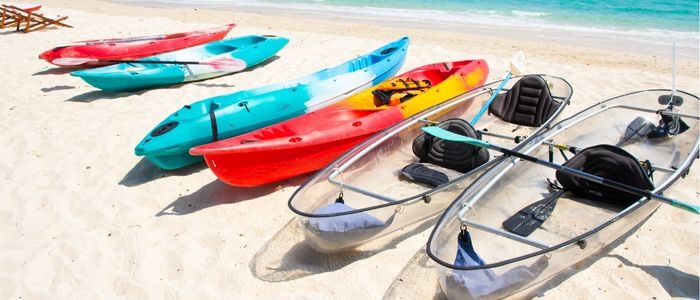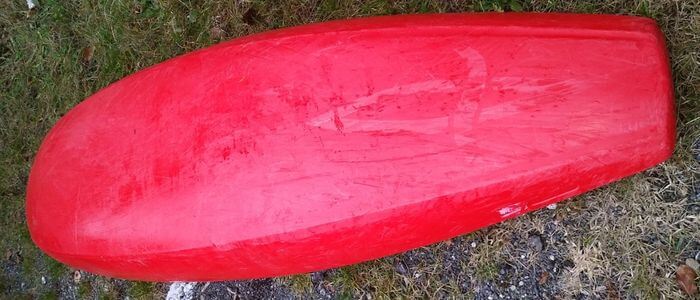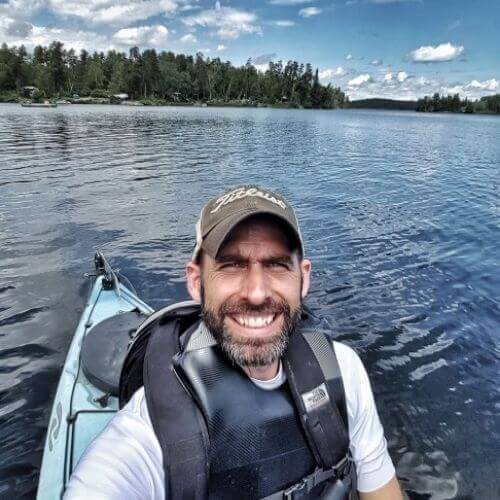
Oil Canning in a kayak is an all too familiar sight, especially if you spend any time out on the water. As your boat moves across the waves, its hull may flex and bend with joints that begin to resemble oil cans – hence the name. This phenomenon can be both annoying and even dangerous, so it’s important to understand what causes it, what preventive measures can be taken against it, and how to minimize or fix problems after they arise.
This blog post will cover everything you need to know about kayak oil canning and how to prevent or manage its effects for safe paddling no matter where life takes you!
So, let’s get started.

Oil canning describes when a kayak’s hull flexes and bends due to its design, construction material, or use over time. This flexing causes small joints at various points on the kayak’s hull to resemble oil cans, resulting in an undesirable aesthetic.
Moreover, this deformation can also lead to structural weaknesses that may be dangerous in certain situations – such as if you encounter rough waters or large waves while paddling.
Oil Canning might happen with anyone regardless of their experience level or the materials used to build the kayak. However, it is more common in beginner boats made of cheaper materials like plastic.
So, it’s better to understand what causes oil canning in kayaks and what you can do to prevent or manage it for safe paddling.
Knowing these will help you enjoy your kayaking experience and avoid potential dangers.
So, let’s discuss some common reasons behind Oil Canning in your kayak.
Knowing the causes of oil canning on a kayak is important for avoiding or finding ways to fix the issue. Some of the most common reasons behind this phenomenon include the following:
Poorly designed hulls present a serious safety concern for kayakers and can make navigating rough water an especially dangerous task. When too much flexibility is built into a hull, it begins to bend with every wave more than it should, resembling the shape of oil cans.
This distortion is often due to construction from high-pressure hull material in areas with low pressure, leading to instability and an increased risk of damage or other accident.
When storing a kayak, it is important to keep the temperature consistent. Since some materials, particularly plastic, are more prone to heat and cold damage than others, the kayak can warp if stored in an area with extreme temperatures.
The flexing caused by such fluctuations is known as oil canning and, over time, can permanently damage the structure of your boat.
Kayaking can be a fun, rewarding experience, but it’s also important to respect the intended purpose of your kayak. Improper paddling could result in oil canning, a deformation of the hull and joints due to repeated stress on the material.
Extreme watersports like whitewater rafting should only be attempted with a touring kayak specifically built for such activities. Otherwise, stick to recreational boats in calm bodies of water and enjoy the paddle.
Kayaking is an activity that requires proper preparation to be done safely and with minimal damage to the kayak. While many people spend money on the best kayaks and accessories, care must be taken when transporting them.
Improper transportation can damage not only your kayak but also can cause what’s known as oil canning – a potentially dangerous problem caused by frequent pressure changes during transport.
To avoid this, ensure your kayak is properly secured when transported so it does not move around too much inside whatever container you’re using. This will help it stay safe while on the road, so you can be sure it’ll be ready for the next time you hit the water.
So these were some common reasons behind Oil Canning in your kayak. Knowing the causes and taking proper precautions can help you to manage it.

As you go through the reasons behind Oil Canning in your kayak, you must wonder how to prevent it. Don’t worry; the following are some tips to prevent Oil Canning:
When choosing a kayak, consider the design of its hull. You should choose one designed to provide stability and prevent oil canning. Beginner kayaks made from plastic are more prone to oil canning, so it’s best to opt for mid-range or higher-grade materials if possible.
It is important to store your kayak in an environment where the temperature remains consistent. This will help prevent any unexpected warping or oil canning of the material due to extreme temperatures.
Make sure you transport your kayak properly so it only flexes a little during transportation. Secure it firmly inside whatever container you’re using for transportation, and make sure it’s stable and steady before you take off.
Always paddle responsibly and only use your boat for the activities it was designed for. This will help ensure your kayak stays durable, and you won’t have to worry about oil canning or other deformations caused by improper usage.
The right kayak for good water is essential. If you plan to paddle in extreme waters like whitewater rafting, choose a touring kayak for such activities.
This will help ensure that your boat can handle the rough conditions and will not suffer from oil canning due to incorrect usage.
Finally, always handle your kayak and its accessories with care. This will help you avoid any damages to your boat that can result in oil canning.
With these tips, you can reduce the chances of oil canning in your kayak and enjoy a better experience on the water!
But if you are facing Oil Canning issues in your kayak, you must be looking for some fixes. Let’s discuss some quick and easy fixes.
Following are some of the methods you can apply to fix oil canning in your kayak:
Heat shaping is one of the easiest and fastest methods to fix oil canning. In this method, you will have to follow the steps given below.
Step 1: Look for the exact location of Oil Canning on your kayak.
Step 2: Now flip your kayak upside down and leave it in a place where sunlight directly hits the area of Oil Canning in your kayak.
Step 3: You will have to leave your kayak for almost 2 hours or more to give the heat enough time to take effect.
Step 4: After two hours, you can flip your kayak to its right position and check if the Oil Canning has been fixed.
If the first method doesn’t work, you can use hot water to fix the Oil Canning. In this method, you will have to follow the steps given below.
Step 1: Look for the exact location of Oil Canning in your kayak.
Step 2: Now fill your kayak with hot water (not boiling water) and make sure that the water puts pressure on the area of Oil Canning.
Step 3: You will have to leave the Kayak for around 30-40 minutes until you notice that the material has softened up.
Step 4: After 40 minutes, you can check your kayak and see if the Oil Canning has been fixed.
If the first two methods don’t work, you can use a heat gun or hair dryer to fix the Oil Canning in your kayak. In this method, you will have to follow the steps given below.
Step 1: Look for the exact location of Oil Canning on your Kayak.
Step 2: Start heating the area with either a heat gun or a hair dryer. Make sure you hold it at least 10-15 cm away from your boat while applying heat to prevent damage.
Step 3: You must ensure that the material gets heated thoroughly and evenly throughout the process.
Step 4: Once it’s finished, please allow enough time for cooling down before checking if the oil canning has been fixed.
If none of the above fixes helped you fix Oil Canning, then you should try the hull reinforcement technique. Repairing oil canning by reinforcing the hull is one of the most common ways.
This process involves adding a layer of fiberglass on the outside of your kayak’s hull to help reinforce it and prevent further warping or deformation.
Although applying this method properly requires a great amount of skill and precision, it will help you permanently fix the Oil Canning issue if done correctly.
The last resort to fixing oil canning in your kayak is to seek help from a professional repairing service.
These services are experienced and have the tools to properly assess and repair the damage caused by Oil Canning. Although it may cost you some money, it will be worth it if you want the best possible results for your Kayak.
Oil Canning can be a nuisance for kayakers, but with the help of these quick and easy methods, you can easily fix it. More importantly, you should prevent Oil Canning from happening in the first place by properly maintaining and properly storing your kayak.

Hey there kayak lovers! I’m Jay Schwartz, the author here at Kayak Guidance! You know water sports – you know me! My life is all about it. Kayaking, Paddleboarding, Fishing, Snorkeling and so much more. I love to share my passion and knowledge with all of you.

Hey there kayak lovers! I’m Jay Schwartz, the author here at Kayak Guidance! You know water sports – you know me! My life is all about it. Kayaking, Paddleboarding, Fishing, Snorkeling and so much more. I love to share my passion and knowledge with all of you.

Welcome to KayakGuidance.com! If you’re looking to have some fun outdoor water adventures, then you have come to the right place. We help our readers find the best kayaks and water related equipment to help you have the best time of your life whenever you are engaging in water activities.
This site is a participant in the Amazon services LLC associates program, an affiliate advertising program designed to provide a means for sites to earn advertising fees by advertising and linking to Amazon.com.